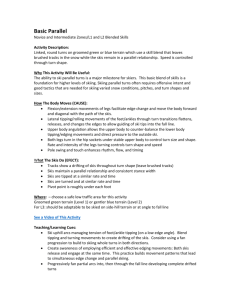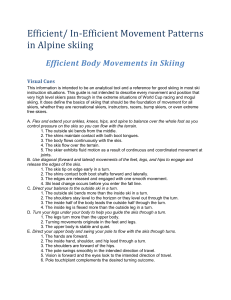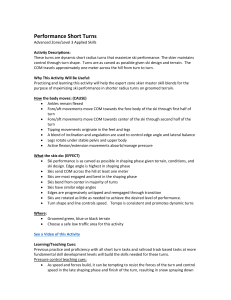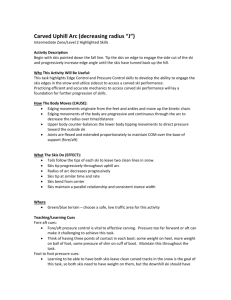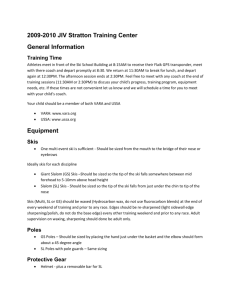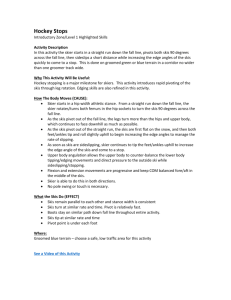New Instructor Training (Alpine)
advertisement
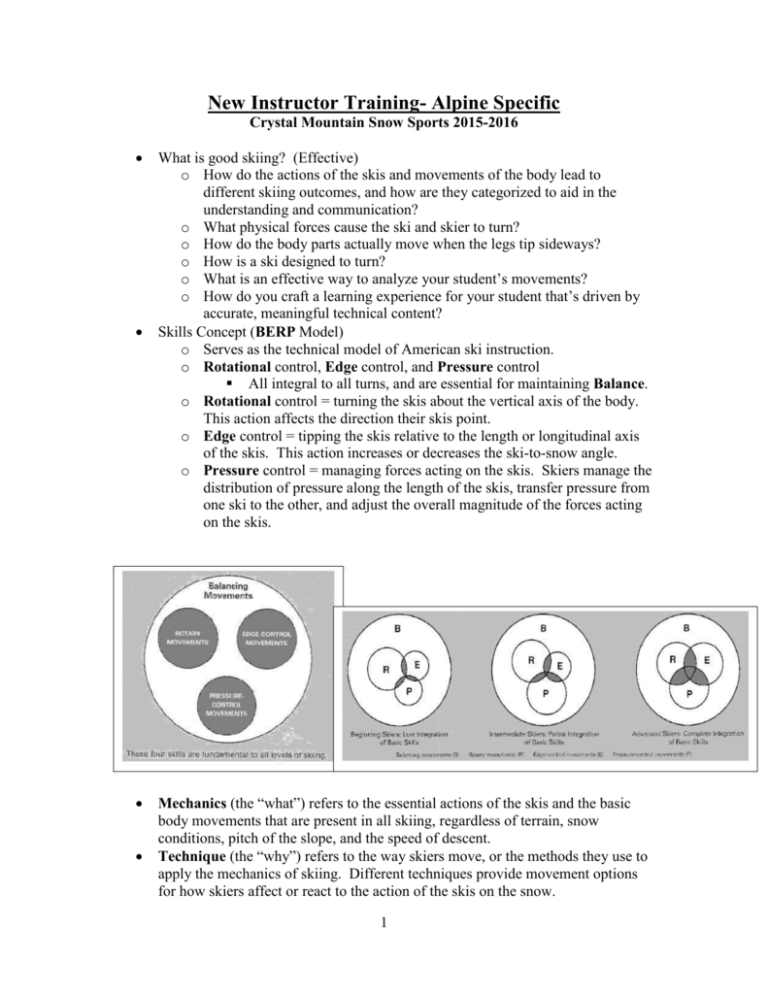
New Instructor Training- Alpine Specific Crystal Mountain Snow Sports 2015-2016 What is good skiing? (Effective) o How do the actions of the skis and movements of the body lead to different skiing outcomes, and how are they categorized to aid in the understanding and communication? o What physical forces cause the ski and skier to turn? o How do the body parts actually move when the legs tip sideways? o How is a ski designed to turn? o What is an effective way to analyze your student’s movements? o How do you craft a learning experience for your student that’s driven by accurate, meaningful technical content? Skills Concept (BERP Model) o Serves as the technical model of American ski instruction. o Rotational control, Edge control, and Pressure control All integral to all turns, and are essential for maintaining Balance. o Rotational control = turning the skis about the vertical axis of the body. This action affects the direction their skis point. o Edge control = tipping the skis relative to the length or longitudinal axis of the skis. This action increases or decreases the ski-to-snow angle. o Pressure control = managing forces acting on the skis. Skiers manage the distribution of pressure along the length of the skis, transfer pressure from one ski to the other, and adjust the overall magnitude of the forces acting on the skis. Mechanics (the “what”) refers to the essential actions of the skis and the basic body movements that are present in all skiing, regardless of terrain, snow conditions, pitch of the slope, and the speed of descent. Technique (the “why”) refers to the way skiers move, or the methods they use to apply the mechanics of skiing. Different techniques provide movement options for how skiers affect or react to the action of the skis on the snow. 1 Tactics (the “why”) refer to the strategic choices skiers make in order to achieve a goal. Decisions are based on intent, knowledge, and level of performance within the context of skiing environment. Skiers may choose to adjust turn shape, speed, line, timing, or technique to accommodate factors such as snow conditions and terrain. Rotational Control: Leg Rotation: movement of the lower body to affect the direction the skis point. o …is the most versatile, and, therefore, most effective source of rotational input in most skiing applications. o …constant source of rotational input throughout the entire turn o …combined with other forms of rotation when necessary o As the body flexes, abduction (movement away from midline of body) and adduction (movement toward midline of body) have greater effect on rotational control. Counter-Rotation: o Upper and Lower Body separation Upper Body = pelvis and above Lower Body = top of femurs down Hip joint is the connection between to two. o Most effective in situations requiring immediate, strong rotational input to the skis. o An instant but short-lived source of rotational input. o Most effective in short turns (discuss) Anticipation: o A position or anticipatory movement in preparation for turning, in which the upper body actively turns to face down the hill rather than across the hill in the direction of the skis. o Purpose is to stretch and engage muscles to create a strong reaction when the skier releases the edges (coiling and uncoiling a spring). o …a preparatory move that transfers strong rotational input to the skis when the edges are released. o …commonly used in short-radius turns with a blocking pole plant to help stabilize the upper body. Rotational Outcomes: o Turning: rotational action of the skis relative to the surface of the snow. A skier’s curved path of descent, or a change in direction of travel. o Steering: actively directing the skis along an intended arc by turning an edged ski (a blend of tipping the skis while turning the legs). Edge Control: 2 Inclination: o Occurs when the skier deviates from a vertical position. Is a lateral movement of a skier toward the inside of a turn. Magnitude of force determines degree of inclination. Angulation: o Refers to movements that create angles between body parts. Hip angulation: is the strongest and most dynamic source of angles. Is most apparent through shaping and finishing phases of the turn. Knee angulation: is used for fine-tuning edge angles. (Discuss “banking”) Sliding: (straight run) forward travel on flat skis. Slipping: (side-slipping) skis sideways to direction of travel. Skidding: blends forward and sideways actions of the skis. o Edge angles may range from nearly flat to very steep. o Edge angles contribute to the shape of the turn, affecting the skier’s speed of descent. Carving: the action of an edged ski traveling forward along the length of the ski with very minimal to no sideways travel. High edge angles allow the bend of the ski to create the arc of the turn, as the tail follows in the path cut by the tip. o Function of edge angle is to access the turning force (centripetal) and minimize braking (friction). o The arc of the turn is created by the edge of the ski. o Higher edge angles and greater degrees of inclination (angulation) will be present with greater speeds. Pressure Control: Requires movements to manipulate forces. o Control the distribution of pressure from tip to tail. o Control the distribution of pressure from one ski to the other. o Control the overall magnitude of pressure acting on the base and/or edge of the skis. CM: Center of Mass BOS: Base of Support Flexion Extension Balance: Gravity Inertia Centripetal 3 Friction Athletic Stance: (static) o Feet approximately hip-width apart. o All major joints flexed o Weight and balance are toward the balls of the feet. o Arms are raised slightly above the waist, with the elbows just in front of the body and the hands positioned slightly wider than the elbows. o The pelvis is neutral (no arch in lower back). o Head is up with vision forward. Dynamic Balance: o Balance in motion o Is a result of effective blending of skills to create desired outcomes. o Is achieved through accurate movements. 5 Fundamentals: o Manage Fore/Aft Pressure Along Entire Length of Ski (CM/BOS) o Lateral Pressure Control: Outside Ski to Outside Ski o Edge Control: Create Edge Angles through Inclination and Angulation o Rotational Control: Control Skis’ Rotation through Rotation of Femurs and Upper and Lower Body Separation. o Regulate Magnitude of Forces Created through Ski/Snow Interaction: Extension and Retraction Teaching: Core Concepts: o VAK o CAP o Teaching Model Beginner/Novice Zone o Introduction to equipment o Athletic Stance and Movement (WITHOUT SKIS) o Movement on skis (flat terrain) o Sidestep/Herringbone o Sliding (straight run) o Progressions through straight run (hops, glide on one ski, etc.) o Gliding wedge o Braking wedge o Linked wedge turns o Traverse o Sideslip o Forward sideslip o Wedge Christie Intermediate Zone 4 o o o o o o o o o o o Wedge Christie Garlands Parallel Turn Parallel Turns of Varying Size Pivot Slips Hockey Stops Fan Progression Railroad Tracks Falling Leaf Carved Parallel Turns Step Turns for Tactical Turn Entry Advanced Zone o Carved Parallel Turns o Short-radius Carved Turns o Long-radius Carved Turns o Bumps o Powder/Crud/Ice o Gates/Race Training 5

